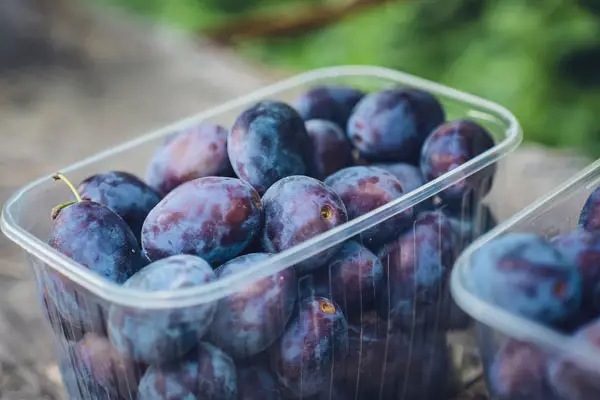There are two common types of plum aphids, leaf-curling aphids and mealy plum aphids. Plum aphids are small insects that feed on the foliage and fruits and can severely damage leaves. Mealy plum aphids are pale green insects that can leave a sticky honeydew residue over affected foliage. Both are known as sap-sucking insects that can be seen from April to September.

Both aphids are active during spring and summer and despite causing unsightly damage, the actual fruit yield is unaffected. Many gardeners leave these aphids alone, safe in the knowledge that future crops and the overall health of the tree won’t be adversely affected.
Jump To...
Fruit Trees Vulnerable to Plum Aphids
Although fruit yield is often healthy, even with plum aphids, it’s handy to know what fruits to expect to find them on.
Leaf-Curling Aphids
- Plum trees
- Sloe
- Damsons
- Greengages
Mealy Plum Aphids
- Plums
- Sloe
- Damsons
- Greengage
Plum Aphid Identification – Life Cycle of Leaf-Curling Aphids
By being aware of the timings of leaf-curling aphids, you can easily spot them by looking at the fruit tree leaves. These aphids won’t always be active or noticeable, so it’s important to understand their life cycle.
Autumn
Eggs are laid in the Autumn time in the base of the fruit stems.
Winter and Spring
Eggs hatch in the winter and spring and they then attach themselves to the leaves causing them to curl.
Summer
You will see evidence of the leaf curling damage these aphids cause and may see them moving about. They are green and also round in shape.
Plum Aphid Identification – Life Cycle of Mealy Plum Aphids
Knowing when and how to spot mealy plum aphids can be a great advantage if you are looking to control them. Also knowing what they look like will help when it comes to identifying them on your fruit tree.
Autumn
In the Autumn their eggs are laid, usually in the base of the buds by the adults.
Spring
The eggs of mealy plum aphids will hatch in the spring. These early generations will be wingless but future ones may produce winged varieties.
Summer
It’s most likely from June onwards when you’ll notice the mealy plum aphid infestation. They are pale green to white in colour and mud will be found in clusters on the underside of leaves and shoots.
Plum Aphid Damage
Both of these aphid infestations can be identified by looking at the damage caused to your fruit trees. But which aphid do you have on your tree? Use the below guide to work out which insect has made it’s home on your plum tree.
Leaf-Curling Aphid Damage
- The most obvious symptom here is seeing curled leaves on your fruit tree in April and May.
- Some leaves may die altogether which can be another sign of the damage they cause.
- The tree can look unsightly but the fruit mostly remains healthy and edible.
Mealy Plum Aphid Damage
- These aphids excrete honeydew so they can also be identified through this sticky residue they leave.
- Spotting sooty mould can be a sure sign of mealy plum aphid and this comes about as a result of the honeydew substance.
- You may notice flower or leaf damage after the mealy plum aphids have sucked the sap from it.
Plum Aphids Treatment & Control
If you spot any signs of leaf-curling aphids or mealy plum aphids there are things you can do to control them. As we’ve already said though, often the damage is only to the appearance of the tree and the fruit itself will be fine. The following lists can be used on either of the plum aphids in this article.
Control
Controlling plum aphid pests comes by knowing when to spot them, what they look like, and where to spot them. Once you’ve established this you can take steps to controlling them if you wish to. Taller trees are more difficult to treat because in order to be successful you need to reach the whole tree.
Organic Control
Organic control is obviously the preferred method because it’s the least harmful to the surrounding wildlife.
- Where possible, leave them be to see out their life cycle for that year. It’s likely there will be no damage to the crop.
- You can squash visible colonies with your fingers if you wish to. This won’t get them all but will reduce the current population.
- Aphid predators such as ladybirds, hoverflies, and beetles should be welcomed and you could set up bug hotels around the garden.
- Earwigs are known to be a big predator of aphids, so why not make some ideal nest sites for them?
Pesticide Control
Should the above methods fail or your problem is more extensive you can fall back on a pesticide solution.
- Ideally any pesticide control needs to happen before the leaf curling takes place, otherwise your efforts won’t matter.
- You can use a plant oil winter wash which will kill any overwintering eggs.
- Tall trees will be more of an issue because the whole tree needs spraying.
- Contact-action insecticides can be used, but cautiously and always read the full instructions.
Our guide to plum pests and diseases will help you identify and avoid common plum tree problems, and provide treatment information.




